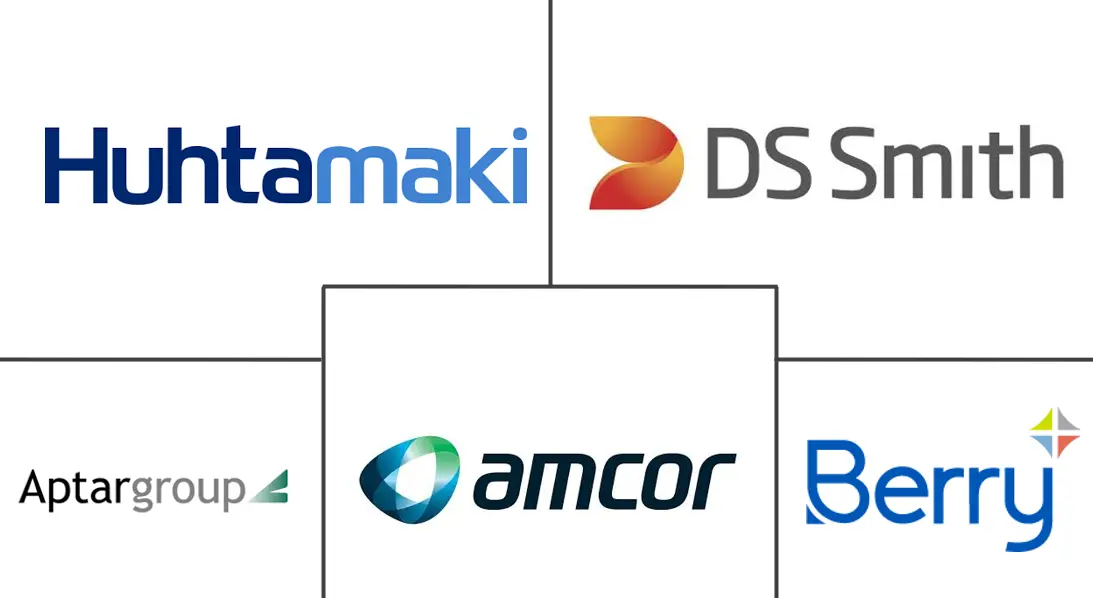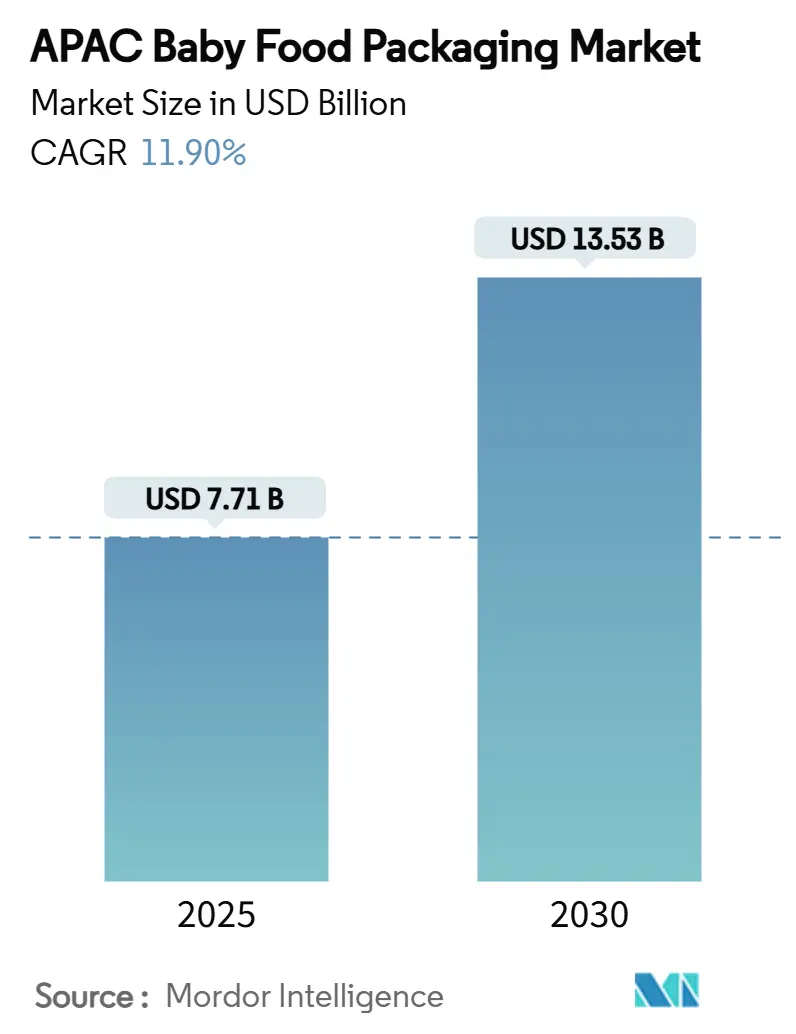
APAC Baby Food Packaging Market Analysis by Mordor Intelligence
The APAC Baby Food Packaging Market size is estimated at USD 7.71 billion in 2025, and is expected to reach USD 13.53 billion by 2030, at a CAGR of 11.90% during the forecast period (2025-2030). This expansion reflects the region’s demographic momentum, strong urbanization and the growing preference for premium infant nutrition. Rising birth registrations during China’s Year of the Dragon lifted super-premium infant formula sales by 44.3%, while H&H Group captured 15.6% share of that price tier.[1]NutraIngredients-Asia, “H&H Group rebounds from low infant formula sales in China in Q1,” nutraingredients-asia.com Material innovation is another growth catalyst. Plastic retained 46.7% revenue share in 2024, yet bioplastics are climbing fastest at 18.4% CAGR, supported by NatureWorks’ USD 600 million Ingeo PLA complex in Thailand scheduled for 2025. Convenience-led pouches already hold 33% share and are growing at 15.9% CAGR, reshaping packaging line investments and retail shelf layouts. Geographic concentration remains evident as China commands 35% share, while India is registering the quickest 14% CAGR through 2030. E-commerce sales of baby food packaging accelerate at 19.4% CAGR, forcing a pivot toward shipping-robust, lighter formats that minimize breakage and dimensional weight.
Key Report Takeaways
- By material, plastic led with 46.7% of the APAC baby food packaging market share in 2024; bioplastics are forecast to expand at an 18.4% CAGR through 2030.
- By package type, pouches accounted for 33% revenue share in 2024 and are projected to advance at a 15.9% CAGR to 2030.
- By product, powder milk formula held 42.2% share of the APAC baby food packaging market size in 2024, while snacks and finger foods are expected to grow at a 15% CAGR through 2030.
- By age group, 6-12 months captured 39.1% share in 2024; the 2-3 years cohort is estimated to rise at a 14.3% CAGR to 2030.
- By distribution channel, supermarkets and hypermarkets held 46.6% share in 2024, whereas online retail is poised for 19.4% CAGR growth through 2030.
- By country, China retained 35% share in 2024, while India is forecast to register a 14% CAGR through 2030.
APAC Baby Food Packaging Market Trends and Insights
Drivers Impact Analysis
| Driver | % Impact on CAGR Forecast | Geographic Relevance | Impact Timeline |
|---|---|---|---|
| Growing demand for packaged baby food & infant formula | +3.2% | China, India, Southeast Asia | Medium term (2-4 years) |
| Rising dual-income urban households | +2.8% | Urban centers across APAC | Long term (≥ 4 years) |
| Expansion of organised retail & e-commerce | +2.1% | China, India, Indonesia, Thailand | Short term (≤ 2 years) |
| Brand-led shift toward convenience pouch formats | +1.9% | Global APAC | Medium term (2-4 years) |
| Government subsidies for bio-based packaging lines | +1.4% | Thailand, Vietnam, Malaysia | Long term (≥ 4 years) |
| OEM investment in in-house flexible converting capacity | +1.1% | China, India, Japan | Medium term (2-4 years) |
| Source: Mordor Intelligence | |||
Growing demand for packaged baby food and infant formula
China’s infant formula segment stayed resilient in 2024 as foreign brands logged 8% sales growth, with the super-premium tier securing 37% share.[2]China International Import Expo, “Several foreign infant formula brands see strong growth in China in 2024,” ciie.org Parents in urban APAC favor products that guarantee safety, extended shelf life and superior nutrition, prompting demand for multi-layer barrier films and premium finishes. Generational wealth transfer brings millennial purchasing power that privileges convenience and perceived quality over homemade alternatives. Urban-rural divides remain, yet metropolitan centers have become high-density demand clusters.
Rising dual-income urban households
Households with two earners value packaging that supports hectic routines. Spouted pouches enable on-the-go feeding, easy resealability and reduced mess, aligning with parental expectations. Affluence in South Korea and Singapore accelerates adoption of premium, portion-controlled packs, while Vietnam and Indonesia are beginning to mirror the trend as female labor participation rises. Brands are therefore prioritizing ergonomic shapes, soft-touch laminates and quick-open closures suitable for one-hand use.
Expansion of organised retail and e-commerce
Digital commerce is scaling at 19.4% CAGR, reshaping distribution physics. Packages require higher drop-test thresholds and optimized cube efficiency to survive courier networks. Direct-to-consumer brands use e-commerce to bypass shelf competition, so on-pack graphics must convey trust and quality during thumbnail-level browsing. In markets like Indonesia, rising supermarket penetration still contributes to volume growth, yet omnichannel models dominate strategic planning.
Brand-led shift toward convenience pouch formats
Pouches captured more than 30% share globally, led by Cheer Pack designs that integrate tamper-evident, no-spill spouts.[3]Cheer Pack North America, “Food & Beverage — Baby Food,” cheerpack.com For producers, lighter weight means lower logistics emissions and shelf-count maximization. Custom silhouettes and photo-realistic printing upgrade shelf impact, while aseptic filling widens application scope. Developed APAC economies exhibit rapid pouch uptake whereas glass jars maintain relevance in certain niche or gifting occasions.
Restraints Impact Analysis
| Restraint | % Impact on CAGR Forecast | Geographic Relevance | Impact Timeline |
|---|---|---|---|
| Stringent bans on single-use plastics | -2.3% | India, Southeast Asia, Australia | Short term (≤ 2 years) |
| Volatility in food-grade resin pricing | -1.8% | Global APAC | Short term (≤ 2 years) |
| Cultural preference for home-cooked baby food | -1.5% | Rural APAC, traditional markets | Long term (≥ 4 years) |
| Recycling-infrastructure gaps across emerging SE-Asian economies | -1.2% | Vietnam, Indonesia, Philippines | Medium term (2-4 years) |
| Source: Mordor Intelligence | |||
Stringent bans on single-use plastics
India mandates 30% recycled content by 2025 in many rigid categories, forcing accelerated R&D and qualification cycles.[4]Lorax EPI, “Revolutionising packaging: The rise of post-consumer recycled content,” loraxcompliance.com Producers face added costs for certified PCR resin and tighter specifications on migration and odor. Parallel measures in Singapore and Indonesia add complexity for multinational supply chains that must juggle differing compliance deadlines.
Volatility in food-grade resin pricing
Polyethylene and polypropylene each rose multiple cents per pound in late 2024 amid feedstock tightness. Such swings compress converter margins and disrupt pricing commitments to brand owners. Several packagers hedge by forward-buying or diversifying into bio-resin blends, but smaller firms struggle to absorb the volatility. Investment in digital procurement platforms and long-term offtake agreements is therefore rising.
Segment Analysis
By Material: Bioplastics drive sustainable transformation
Plastic dominated the APAC baby food packaging market in 2024 with 46.7% revenue share. Bioplastics, however, are charting an 18.4% CAGR to 2030, supported by Thailand’s pro-investment regime and multinational brand pledges on carbon neutrality. The APAC baby food packaging market size for bioplastics is expected to grow the fastest as capacity from NatureWorks and SKC reduces cost differentials with petro-based polymers. Government subsidies in Thailand and Vietnam lower capital thresholds, while improved processability allows bio-based PLA and PBAT films to match heat resistance and sealing integrity of conventional flexibles.
Price sensitivity still limits uptake in several emerging economies, yet premium and organic baby food brands are using compostable packs as a brand story. Glass maintains relevance in luxury gifting, yet its weight and fragility reduce competitiveness in e-commerce. Metal can demand is retreating in favor of lighter barrier laminates. Paperboard, often coupled with bio-barrier coatings, retains a niche for premium secondary packs.
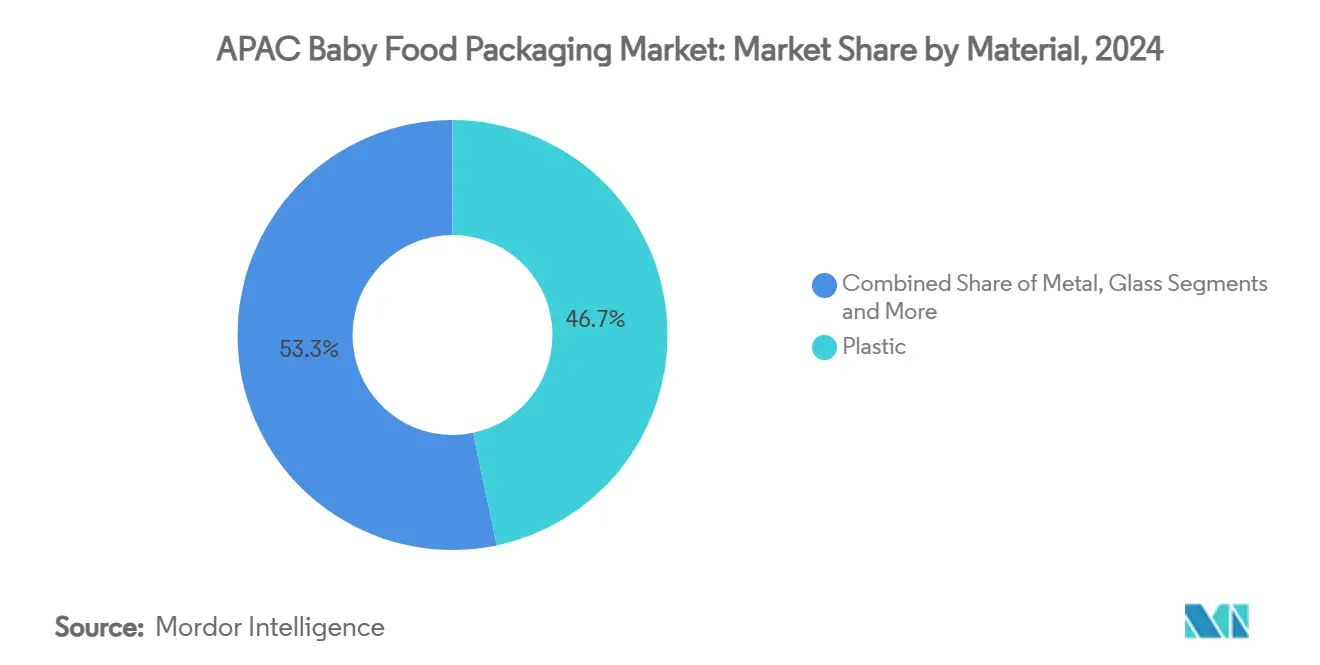
Note: Segment shares of all individual segments available upon report purchase
By Package Type: Pouches revolutionize convenience
Pouches held 33% share of the APAC baby food packaging market in 2024. They are forecast to expand at 15.9% CAGR, propelled by spouted designs that support independent toddler feeding. The APAC baby food packaging market size for pouches is therefore widening more quickly than rigid formats. Bottles stay important for ready-to-drink formula, but SIG and Tetra systems now compete with mono-material flexibles that claim lower carbon footprints. Metal cans are losing shelf appeal due to weight penalties and are being displaced in club stores by stand-up pouches with fitments that offer similar barrier levels.
Manufacturers appreciate the logistics benefits of pouches, which reduce inbound freight volumes and warehouse space. Retailers gain faced-up shelf density and improved sell-through as consumers embrace the lighter format. Sachets remain a cost-effective option in Indonesia and the Philippines, where single-use affordability trumps sustainability concerns. Jars persist for premium organic purées but are trending toward lightweight PET rather than glass.
By Product: Snacks drive category expansion
Powder milk formula led with 42.2% share in 2024, underpinning the category’s scale. Snacks and finger foods show a 15% CAGR thanks to parents prioritizing motor skill development and taste exploration. Flexible pouches with nitrogen flushing maintain crispness and portion control, while canisters with peel-off foil offer tamper evidence. Dried baby food remains popular in Japan and Korea due to reconstitution convenience. Liquid milk formula registers lower growth because its higher transport cost and shorter shelf life favor domestic supply, whereas powder formats dominate export trade.
Brand owners increasingly launch organic rice puff sticks and fruit-vegetable melts that carry higher profit margins. Packaging must therefore balance oxygen barrier with dispersion convenience, driving multi-layer film innovation. Specialized nutrition SKUs for allergy management and sensitive digestion are also on the rise, often requiring opaque high-barrier laminates to protect probiotic efficacy.
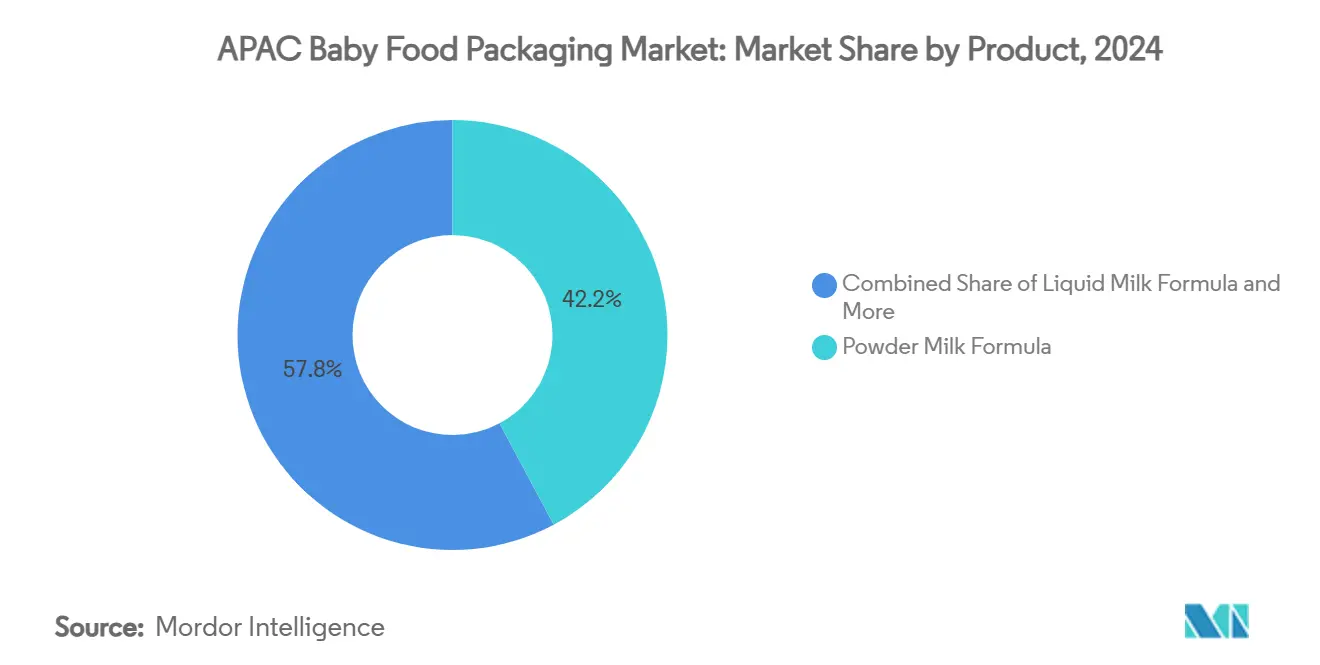
Note: Segment shares of all individual segments available upon report purchase
By Age Group: Toddler segment accelerates growth
The 6-12 months cohort retained 39.1% share in 2024, reflecting the traditional weaning window when solid food is introduced. The 2-3 years segment is projected to climb at 14.3% CAGR as brands extend portfolios into developmental nutrition. Pouch formats with textured nozzles encourage self-feeding and sensory exploration, while resealable cups support portion flexibility. The APAC baby food packaging market share by age group suggests packaging sizes diversify, with single-serve packs targeting infants and multi-serve tubs aimed at toddlers.
Extended breastfeeding trends keep the 0-6 months segment steady rather than rising. The 1-2 years group experiences moderate growth as cross-over snacks blur the line between toddler and mainstream categories. Safety features such as choke-proof caps and tamper rings remain mandatory across all ages, yet ergonomic design is most pronounced for the actively mobile 2-3 years group.
By Distribution Channel: E-commerce transforms retail
Supermarkets and hypermarkets delivered 46.6% of 2024 value, yet online retail is growing fastest at 19.4% CAGR. The APAC baby food packaging market size attributable to e-commerce necessitates designs that resist compression and temperature swings. Drop-testing standards for courier networks are stricter than for palletized retail, influencing material choices such as thicker pouch laminates or HDPE bottles with impact modifiers.
Click-and-collect models blend brick-and-mortar with digital convenience, so secondary packaging must carry clear QR codes and damage-resistant labels that survive multiple handling points. Pharmacies remain trusted outlets for specialty formulas and therapeutic nutrition, demanding premium blister seals and traceability codes. Convenience stores in metro transit hubs cater to immediate needs with small-format SKUs. Direct-to-consumer subscription boxes provide predictable demand which helps packagers optimize production runs.
Geography Analysis
China retained 35% share of the APAC baby food packaging market in 2024 and remains the innovation center for barrier films tailored to super-premium formula. The super-premium tier achieved 37% share that year, while foreign brands enjoyed 8% sales growth despite demographic softness. Packaging suppliers benefit from China’s stringent GB 4806.15-2024 adhesive rules effective February 2025, which raise safety benchmarks and foster demand for high-purity raw materials. Investment in closed-loop recycling is also growing, as local governments prioritize waste reduction and consumers show heightened eco-concerns.
India is forecast to post a 14% CAGR to 2030, supported by rapid urbanization and dual-income families. Dhunseri Group earmarked INR 22 billion (USD 254.4 million) for PET film capacity expansion by 2029 that will underpin domestic supply. Regulatory frameworks are modernizing as FSSAI tightened labeling obligations in June 2024, prompting packagers to adopt clearer nutrition panels. E-commerce growth in tier-two and tier-three cities widens access, while competitive pricing dynamics favor flexible packs over rigid glass.
Southeast Asia forms a patchwork of opportunities. Thailand benefits from USD 600 million NatureWorks and USD 19.3 billion Braskem Siam bio-chem projects that anchor a regional biopolymer hub. Vietnam attracts biodegradable plastic ventures and shows strong e-commerce uptake. Indonesia and the Philippines record high birth rates, but recycling infrastructure deficits restrain sustainable material rollouts. Malaysia’s amendment of Food Regulations 1985 in 2025 and Thailand’s new labeling mandate issued in 2024 raise compliance hurdles. Across the bloc, rising disposable income and smartphone penetration reinforce demand for premium packaging aligned with digital retail.
Competitive Landscape
The APAC baby food packaging market is moderately consolidated. Amcor’s USD 8.4 billion purchase of Berry Global, finalized in April 2025, created an entity with 400 plants across 140 countries and USD 650 million synergy potential. Scale expansion allows deeper R&D budgets for recyclable laminates and barrier papers. Huhtamaki, Tetra Laval and SIG intensify competition through proprietary coating and aseptic filling technologies that enhance nutrient protection while shrinking pack weight.
Sustainability steers rivalry. Firms race to secure patents on bio-based or mono-material structures that meet emerging collection systems. Amcor’s AmFiber Performance Paper patent granted in January 2025 underscores the strategic value of IP in low-carbon packaging. Smaller disruptors such as Accredo Packaging exploit agility to launch sugarcane-based pouches that comply with USDA Biobased labeling. Partnerships between converters and biotech companies are common, linking fermentation science with extrusion competency.
Vertical integration gains traction as OEMs bring printing and lamination in-house to mitigate resin price shocks. Investment in robotics and vision systems improves line speeds and defect detection, reducing downtime and ensuring food safety. Digital watermarking pilots in Japan and South Korea enable pack traceability and facilitate sortation for recycling. White-space opportunities persist in child-resistant closures for supplement lines, smart temperature indicators for cold-chain monitoring and subscription-ready ship-in-own-container formats.
APAC Baby Food Packaging Industry Leaders
Amcor PLC
Huhtamaki Oyj
Aptar Group Inc.
Berry Global Inc.
DS Smith Plc
- *Disclaimer: Major Players sorted in no particular order
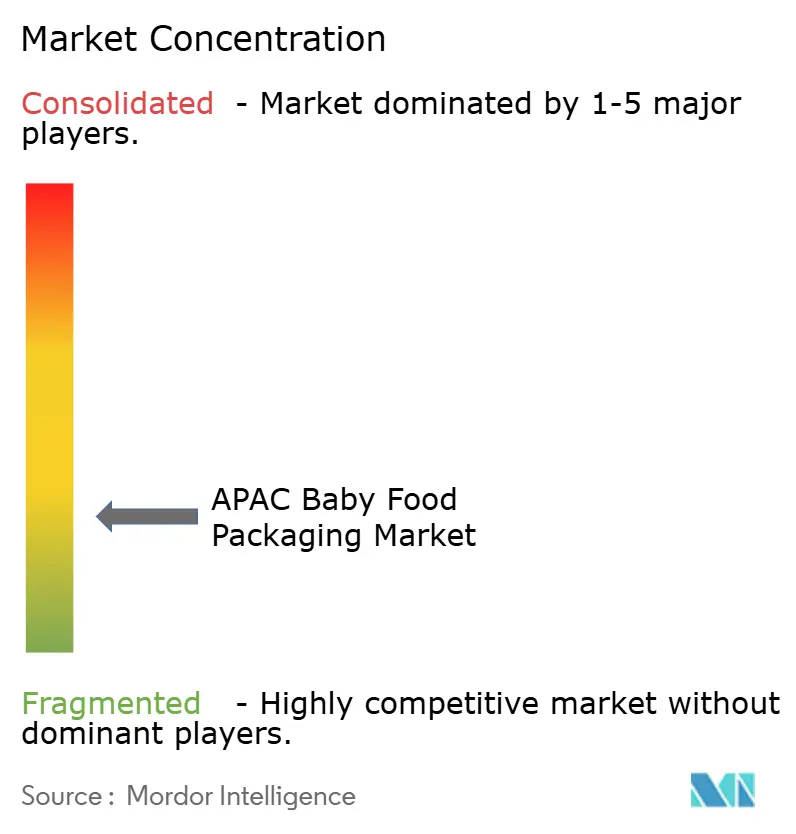
Recent Industry Developments
- June 2025: Japan launched a Positive List system for synthetic resins in food contact materials, raising compliance benchmarks.
- April 2025: Amcor completed its USD 8.4 billion all-stock acquisition of Berry Global, forming a packaging leader with 400 plants worldwide and targeted USD 650 million annual synergies.
- February 2025: China enforced GB 4806.15-2024, a comprehensive food-contact adhesive standard tightening baby food packaging safety.
- January 2025: Amcor obtained a European patent for AmFiber Performance Paper, a recyclable high-barrier paper pack.
APAC Baby Food Packaging Market Report Scope
Baby food packaging encompasses the materials and containers that safeguard baby food products, ensuring their safety, freshness, and nutritional value. Designed with hygiene in mind, it prevents contamination and offers parents conveniences like resealability, tamper-evidence, and portability. With rising consumer concerns about safety and sustainability, packaging manufacturers are pivoting towards eco-friendly materials. These materials lessen environmental impact and fulfill the essential function of keeping baby food safe and easily accessible. Furthermore, packaging is a medium to communicate the product's quality and trustworthiness to consumers, often achieved through informative and attractive designs.
Asia Pacific Baby Food Packaging Market is segmented by material (plastic, paperboard, metal, glass), by package type (bottles, metal cans, cartons, jars, pouches, and other packaging types), by-products (liquid milk formula, dried baby food, powder milk formula, prepared baby food and others) and by Country (China, India, Japan, South Korea, South East Asia and Rest of Asia Pacific). The market sizes and forecasts are provided in terms of value in (USD) for all the above segments.
| Plastic |
| Paperboard |
| Metal |
| Glass |
| Bioplastics |
| Bottles |
| Metal Cans |
| Cartons |
| Jars |
| Others |
| Dried Baby Food |
| Liquid Milk Formula |
| Powder Milk Formula |
| Snacks and Finger Foods |
| Others |
| 0-6 Months |
| 6-12 Months |
| 1-2 Years |
| 2-3 Years |
| Supermarkets / Hypermarkets |
| Convenience Stores |
| Pharmacies and Drugstores |
| Online Retail |
| Others |
| China |
| India |
| Japan |
| South Korea |
| Indonesia |
| Thailand |
| Malaysia |
| Rest of Asia-Pacific |
| By Material | Plastic |
| Paperboard | |
| Metal | |
| Glass | |
| Bioplastics | |
| By Package Type | Bottles |
| Metal Cans | |
| Cartons | |
| Jars | |
| Others | |
| By Product | Dried Baby Food |
| Liquid Milk Formula | |
| Powder Milk Formula | |
| Snacks and Finger Foods | |
| Others | |
| By Age Group | 0-6 Months |
| 6-12 Months | |
| 1-2 Years | |
| 2-3 Years | |
| By Distribution Channel | Supermarkets / Hypermarkets |
| Convenience Stores | |
| Pharmacies and Drugstores | |
| Online Retail | |
| Others | |
| By Country | China |
| India | |
| Japan | |
| South Korea | |
| Indonesia | |
| Thailand | |
| Malaysia | |
| Rest of Asia-Pacific |
Key Questions Answered in the Report
What is the current value of the APAC baby food packaging market?
The market is valued at USD 7.71 billion in 2025 and is projected to reach USD 13.53 billion by 2030.
Which packaging material is growing fastest?
Bioplastics are expanding at an 18.4% CAGR through 2030, supported by large-scale PLA and PBAT investments in Thailand and Vietnam.
Why are pouches gaining popularity in baby food?
Pouches offer portability, reduced breakage and easy self-feeding, helping them grow at a 15.9% CAGR and hold 33% market share in 2024.
Which country will drive the highest growth?
India is forecast to register the fastest 14% CAGR due to urbanization, dual-income families and improved retail infrastructure.
How is e-commerce changing packaging design?
Online retail’s 19.4% CAGR forces packagers to engineer more robust, cube-efficient formats that withstand parcel shipping while maintaining product integrity.
What regulatory changes are shaping material choices?
China’s GB 4806.15-2024 adhesive rules, India’s updated labeling standards and Japan’s Positive List for resins tighten safety requirements and accelerate the shift to compliant, sustainable materials.
